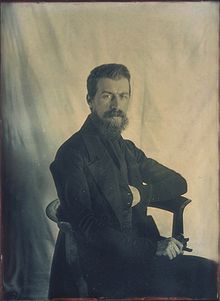Peter Wilhelm Friedrich von Voigtländer
Peter Wilhelm Friedrich Ritter von Voigtländer (born November 17, 1812 in Vienna , † April 8, 1878 in Braunschweig ) was a German-Austrian entrepreneur , optician and photography pioneer .
Life
Peter Wilhelm Friedrich von Voigtländer established the Voigtländer company founded by his grandfather Johann Christoph Voigtländer as the leading photographic company of its time.
The exposure time of the daguerreotypes could already be shortened in 1840 with the first scientifically calculated portrait lens of the Viennese professor Josef Petzval . Voigtländer was the first to build it on behalf of Petzval, making it famous throughout Europe. It had 16 times the speed of the lens used in the first daguerreotype cameras.
At the same time as the lens - and of course equipped with it - Voigtländer also developed his own camera for daguerreotypes. For the first time it was made entirely of metal and had the shape of a cone. Voigtländer was a member of the “Fürstenhof Round”.
Voigtländer's earliest personal photograph was taken in the early 1840s, probably at the same time as the Swiss daguerreotype artist Johann Baptist Isenring (1796–1860) exhibited in Voigtländer's shop in February 1843. In 1845 he married Nanny Verw. Prongs Langenheim (1813–1902), daughter of the Braunschweig lawyer and notary Friedrich Wilhelm Langenheim. In 1868 he moved the company's headquarters to his wife's hometown - Braunschweig .
His stepson, the scientist and composer Hans Sommer , founded the Institute for Musical Performance Rights (AFMA) together with Richard Strauss in 1903, the first predecessor organization of what would later become GEMA .
Awards
- 1864 the Knight's Cross of the Franz Joseph Order .
- Friedrich Voigtländer was ennobled by the Emperor of Austria in 1867 and raised to hereditary knighthood; the corresponding diploma was issued in 1868.
literature
- Carsten Grabenhorst: Voigtländer & Son. The company history from 1756 to 1914 . Appelhans Verlag, Braunschweig 2002.
- Ilse Erdmann: From Mechanicus Johann Christoph Voigtländer in Vienna to Voigtländer AG in Braunschweig. A brief company history with special consideration of the Voigtländer family, compiled from documents and testimonials from the archives of Voigtländer AG, Braunschweig , Part I. In: Tradition. Journal for company history and entrepreneur biography 7, 1962, p. 12.
- Ilse Erdmann: From Mechanicus Johann Christoph Voigtländer in Vienna to Voigtländer AG in Braunschweig , Part II. In: Tradition. Journal for company history and entrepreneur biography 7, 1962, p. 161.
- Günther: Voigtländer, Peter Wilhelm Friedrich von . In: Allgemeine Deutsche Biographie (ADB). Volume 40, Duncker & Humblot, Leipzig 1896, p. 215 f.
- FXM: Friedrich Wilhelm von Voigtländer In: Ludwig Cabinet (Ed.): Photographische Correspondenz , 2nd year, Carl Gerold's Sohn, Vienna, 1865, p. 311 ff. ÖNB-ANNO
- On the history of the daguerreotype in Vienna . In: Allgemeines Wiener polytechnisches Journal , No. 153, Thursday, December 22nd, 1842, ( digitized version ).
Web links
- Entry on Peter Wilhelm Friedrich von Voigtländer in the Austria Forum (in the AEIOU Austria Lexicon )
- Voigtländer in the Microscope Museum ( Memento from March 3, 2016 in the Internet Archive )
- Wolfgang Burgmer: November 17th, 1812 - birthday of Peter WF Voigtländer WDR ZeitZeichen on November 17th, 2012 (podcast)
Individual evidence
- ↑ Wolfgang Baier: Source descriptions for the history of photography , 2nd edition, Schirmer / Mosel, Munich, 1980, p. 132.
- ↑ Wolfgang Baier: Source descriptions for the history of photography , 2nd edition, Schirmer / Mosel, Munich, 1980, p. 135.
- ↑ James A. Cornwall: The early days of photography in Germany , Verlag für Wirtschaft und Industrie 1979, p. 38 ff.
- ↑ Named after the house of the same name in Vienna on Beatrixgasse, formerly Rabengasse No. 453 in the suburb of Landstrasse, in which the Berlin-born natural scientist, physicist and mathematician Carl Schuh (1806–1863) had his studio. In addition to v. Ettingshausen also August Artaria (1807-1893), Joseph Petzval , Carl Schuh, Christian Joseph Edler von Berres , Franz Kratochwila, Friedrich Wilhelm Voigtländer, Anton Georg Martin (1812-1882), the doctor Erwin Waidele, Wenzel Prokesch, the brothers Johann and Josef Natterer , the pharmacist's son Carl Reisser (1815–?) And a few others.
- ↑ Note sheet . In: Photographisches Journal , Vol. 21, 1864, p. 72.
| personal data | |
|---|---|
| SURNAME | Voigtländer, Peter Wilhelm Friedrich von |
| ALTERNATIVE NAMES | Voigtländer, Peter Wilhelm Friedrich (maiden name) |
| BRIEF DESCRIPTION | Austrian optician and photography pioneer |
| DATE OF BIRTH | November 17, 1812 |
| PLACE OF BIRTH | Vienna |
| DATE OF DEATH | April 8, 1878 |
| Place of death | Braunschweig |



